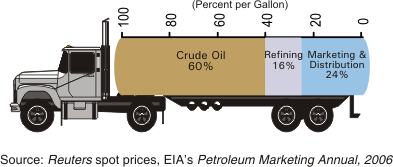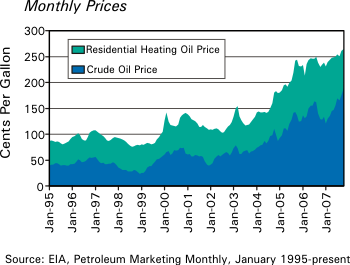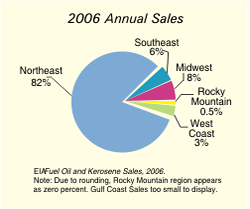| > |
Energy Information Administration Brochures |
|||||||||
|---|---|---|---|---|---|---|---|---|---|---|
Brochure #:DOE/EIA-X048
Residential Heating
Introduction Heating oil is a petroleum product used by many Americans to heat their homes. Historically, heating oil prices have fluctuated from year to year and month to month, generally being higher during the winter months when demand is higher. To understand the reasons for these price variations, consumers need to understand how heating oil is used and how and where it is produced. Who uses heating oil? Of the 107 million households in the United States, approximately 8.0 million use heating oil as their main heating fuel. Residential space heating is the primary use for heating oil, making the demand highly seasonal. Most of the heating oil use occurs during October through March. The area of the country most reliant on heating oil is the Northeast (see box below). Some customers try to beat rising winter prices by filling their storage tanks in the summer or early fall when the prices are likely to be lower. However, most homeowners do not have large enough storage tanks to store the full amount needed to meet winter demands. Because homeowners may have to refill their tanks as often as 4 or 5 times during the heating season, possible rising or spiking prices are a concern. Where does heating oil come from? The United States has two sources of heating oil: domestic refineries and imports from foreign countries. Refineries produce heating oil as a part of the “distillate fuel oil” product family, which includes heating oils and diesel fuel. Distillate products are shipped throughout the United States by pipelines, barges, tankers, trucks and rail cars. Most imports of distillate come from Canada, the Virgin Islands,and Venezuela. Refiners are limited in the amount of heating oil they can make to meet the demands of the winter heating season. Some winter heating oil is produced by refineries in the summer and fall months and stored for winter use. During the coldest winter months, the inventories that are built in summer and fall are used to help meet the high demand. Refiners can increase heating oil production in the winter to a modest degree, but they quickly reach a point where, to produce more heating oil, they would also have to produce more of other petroleum products which could not be sold in sufficient quantities during the winter months. On the other hand, if consumer demand is high for a seasonal product, such as gasoline, refiners may delay producing heating oil for the winter, which may lower inventories at the start of the heating season. This was the case in September and October 2005, after Hurricanes Katrina and Rita shut down Gulf Coast production capacity. As gasoline prices shot up over $3.00 per gallon, refiners had incentive to produce more gasoline at a time when they would normally concentrate on heating oil production. Heating oil prices paid by consumers are determined by the cost of crude oil, the cost to produce the product, the cost to market and distribute the product, as well as the profits (sometimes losses) of refiners, wholesalers and dealers. In 2006, crude oil accounted for 60 percent of the cost of a gallon of heating oil. The next largest component, distribution and marketing costs, accounted for approximately 24 percent of the cost of a gallon of heating oil. Lastly, refinery processing costs accounted for another 16 percent. (See Figure 1.) Figure 1. Heating Oil Price Components, 2006
Why do heating oil prices fluctuate? Heating oil prices paid by consumers can vary over time and by where a consumer lives. Prices can change for a variety of reasons. These include:
Figure 2. Heating Oil Prices Follow Crude Oil
What can you do to lower your heating oil bill? You can arrange to have your tank filled in late summer or early fall when prices are generally lower. Talk to your heating oil dealer about participating in a budget plan to help stabilize your monthly bill. You can also talk to your heating oil dealer about “cap” or fixed price protection programs, which can help keep costs down. You can obtain a home energy audit to ensure that your furnace and appliances are running efficiently before the season begins. You can achieve conservation gains by weatherizing your home, i.e., installing the proper insulation in your house and around your hot water heater. Quick and easy fixes such as caulking and weather stripping windows and doors to seal out cold air also help save energy. Installing a programmable thermostat and reducing temperature settings on your thermostat, especially when you are not at home, are other ways to reduce your heating fuel costs. Lastly, both Federal and State energy assistance programs are available to heating oil customers who have a limited budget. For example, the Low Income Home Energy Assistance Program (LIHEAP) is a Federal program that distributes funds to States to help low-income households pay heating bills. Additional State energy assistance and fuel fund programs may be available to help households during a winter emergency. To find out if you qualify for assistance in your State, see: www.acf.hhs.gov/programs/ocs/liheap/grantees/states.html or contact your local heating oil dealer.
The Energy Information Administration is an independent statistical agency within
|



